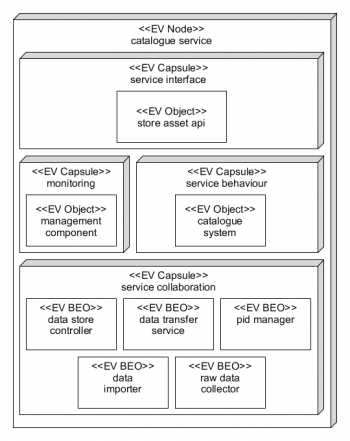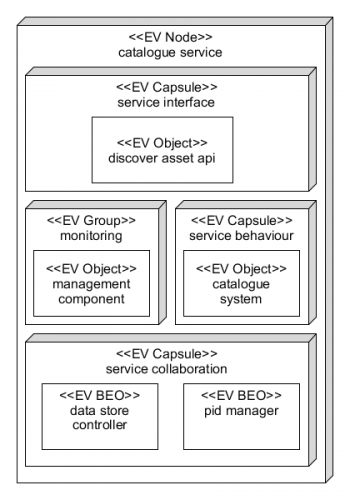Difference between revisions of "Object Configuration (Draft)"
(Created page with "Object Configuration illustrates how the engineering objects are used for supporting the functionalities commonly shared among more than one RI such as Identification and Cita...") |
|||
| Line 30: | Line 30: | ||
In addtion to the EV BEOs all the configurations require a management component object and a catalogue system object. These engineering objects together with the collection of configurations conform the complete catalogue service. | In addtion to the EV BEOs all the configurations require a management component object and a catalogue system object. These engineering objects together with the collection of configurations conform the complete catalogue service. | ||
| + | |||
| + | === <span style="color: #BBCE00">Store Asset Configuration</span> === | ||
| + | |||
| + | {| style="width: 85%;" | ||
| + | |- | ||
| + | | style="width: 65%; vertical-align: top; padding: 10px 10px 10px 10px"| | ||
| + | The configuration for storing a new asset depends on six BEOs: catalogue service, data transfer service, raw data collector, data importer, pid manager, and data store controller. | ||
| + | |||
| + | The figures on the right shows the configuration of the service using the recommended Container Structure. | ||
| + | |||
| + | This configuration shows a self contained service which already contains the required objects for three possible service variations: collect from sensor, import from another repository, and assign global unique pid. | ||
| + | |||
| + | {| class="wikitable" | ||
| + | |- | ||
| + | ! <div style='text-align: left;'>'''<span style="color: #BBCE00">Name:</span>'''</div> | ||
| + | | Store Asset | ||
| + | |- | ||
| + | ! <div style='text-align: left;'>'''<span style="color: #BBCE00">Process:</span>'''</div> | ||
| + | | Store an asset (e.g. dataset) with metadata sufficient for cataloging purposes | ||
| + | |- | ||
| + | ! <div style='text-align: left;'>'''<span style="color: #BBCE00">Resources</span>'''</div> | ||
| + | | | ||
| + | * asset | ||
| + | * metadata | ||
| + | |- | ||
| + | ! <div style='text-align: left;'>'''<span style="color: #BBCE00">Outputs</span>'''</div> | ||
| + | | | ||
| + | * asset [registered] | ||
| + | * metadata [registered] | ||
| + | * asset pid [registered] | ||
| + | |- | ||
| + | ! <div style='text-align: left;'>'''<span style="color: #BBCE00">Options</span>'''</div> | ||
| + | | | ||
| + | * collect data from sensors | ||
| + | * import data from external source | ||
| + | * assign global unique pid | ||
| + | |} | ||
| + | | style="width: 35%; vertical-align: top; padding: 10px 10px 10px 25px"| | ||
| + | [[File:EVCSStoreAsset.png|350px]] | ||
| + | |} | ||
| + | |||
| + | === <span style="color: #BBCE00">Discover Asset Configuration</span> === | ||
| + | |||
| + | {| style="width: 85%;" | ||
| + | |- | ||
| + | | style="width: 65%; vertical-align: top; padding: 10px 10px 10px 10px"| | ||
| + | The configuration for discovering an asset depends on three BEOs: catalogue service, pid manager, and data store controller. | ||
| + | |||
| + | The figures on the right shows the configuration of the service using the recommended Container Structure. | ||
| + | |||
| + | This configuration shows a self contained service which already contains the required objects for supporting the discovery process. | ||
| + | |||
| + | {| class="wikitable" | ||
| + | |- | ||
| + | ! <div style='text-align: left;'>'''<span style="color: #BBCE00">Name:</span>'''</div> | ||
| + | | Discover Asset | ||
| + | |- | ||
| + | ! <div style='text-align: left;'>'''<span style="color: #BBCE00">Process:</span>'''</div> | ||
| + | | Discover an asset using the metadata – the richer the metadata and the more elaborate the query the greater the precision in discovering the required asset(s) | ||
| + | |- | ||
| + | ! <div style='text-align: left;'>'''<span style="color: #BBCE00">Resources:</span>'''</div> | ||
| + | | | ||
| + | * query parameters (metadata) | ||
| + | |- | ||
| + | ! <div style='text-align: left;'>'''<span style="color: #BBCE00">Outputs:</span>'''</div> | ||
| + | | | ||
| + | * metadata | ||
| + | ** asset pid | ||
| + | ** asset reference (publishable) | ||
| + | ** asset description | ||
| + | |- | ||
| + | ! <div style='text-align: left;'>'''<span style="color: #BBCE00">Options:</span>'''</div> | ||
| + | | | ||
| + | * faceted discovery (filtering of results) | ||
| + | |- | ||
| + | ! <div style='text-align: left;'>'''<span style="color: #BBCE00">Correspondences</span>'''</div> | ||
| + | | Technology Viewpoint: [[Catalogue Discovery Object (Draft)|'''Catalogue Discovery Object''']] | ||
| + | |} | ||
| + | | style="width: 35%; vertical-align: top; padding: 10px 10px 10px 25px"| | ||
| + | [[File:EVCSDiscoverAsset.png|350px]] | ||
| + | |} | ||
[[Category:Engineering Viewpoint (Draft)]] | [[Category:Engineering Viewpoint (Draft)]] | ||
Revision as of 23:42, 28 March 2020
Object Configuration illustrates how the engineering objects are used for supporting the functionalities commonly shared among more than one RI such as Identification and Citation, Curation, Cataloguing Configurations, Processing, and Provenance.
Cataloguing Configurations
There are seven cataloguing processes (D8.3) which need to be supported using EV objects. These basic EV configurations are mapped to these processes in Table 01. As shown in the table, the combination of these basic configurations allows supporting different cataloguing processes.
| Processes (User Stories/Requirements) (Stage 1 Description) | Configuration Name |
|---|---|
| 1. Store an asset (e.g. dataset) with metadata sufficient for cataloging purposes; | Store Asset Configuration |
| 2. Discover an asset using the metadata – the richer the metadata and the more elaborate the query the greater the precision in discovering the required asset(s); | Discover Asset Configuration |
| 3. Download an asset based on metadata | Download Asset Configuration |
| 4. Select/project an asset in situ location accessed via metadata | Select Asset Configuration |
| 5. Move (selected parts of) asset to location accessed via metadata | Move Asset Configuration |
| 6. Compose (selected parts of) asset into workflow accessed via metadata | Compose Asset Configuration |
| 7. Update an asset and/or metadata | Update Asset Configuration |
This section define set of seven independent cataloguing services that support each process on Table 01. This clearly separates the functionalities vertically and shows how the BEOs interact with each other. The structure of the following configurations is based on the Container Structure.
In addtion to the EV BEOs all the configurations require a management component object and a catalogue system object. These engineering objects together with the collection of configurations conform the complete catalogue service.
Store Asset Configuration
|
The configuration for storing a new asset depends on six BEOs: catalogue service, data transfer service, raw data collector, data importer, pid manager, and data store controller. The figures on the right shows the configuration of the service using the recommended Container Structure. This configuration shows a self contained service which already contains the required objects for three possible service variations: collect from sensor, import from another repository, and assign global unique pid.
|
Discover Asset Configuration
|
The configuration for discovering an asset depends on three BEOs: catalogue service, pid manager, and data store controller. The figures on the right shows the configuration of the service using the recommended Container Structure. This configuration shows a self contained service which already contains the required objects for supporting the discovery process.
|

